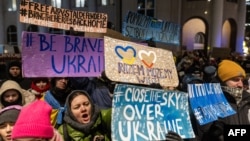The Russian economy in 2023 outpaced both the United States and Europe in terms of growth, increasing in size by 3.6% despite being subject to a wide array of powerful economic sanctions and being cut off from major global markets.
However, growth appears to have been driven mostly by ramped-up spending on the military, as the Kremlin continues its full-scale invasion of Ukraine that it launched nearly two years ago, leading some economists to question whether the growth is sustainable and what side effects it might have.
Rosstat, Russia’s Federal State Statistics Service, on Wednesday reported the growth numbers, which were a stark departure from the 1.2% decline in GDP in 2022, when a coalition of Western countries led by the United States imposed a set of punishing sanctions related to the war in Ukraine.
Russian President Vladimir Putin, who faces an election in March, has said the country’s economy is successfully transitioning away from Western markets and expanding self-sufficiency while simultaneously cultivating new trading relationships.
War spending stimulates economy
The Russian economy is expected to continue growing in 2024, though at a somewhat diminished pace. The Russian government’s forecast of a 2.3% increase in GDP is actually below the 2.6% forecast released by the International Monetary Fund.
Howard J. Shatz, a senior economist at the RAND Corp., told VOA that the source of Russia’s economic growth is not difficult to identify.
“Russia is undergoing a massive fiscal stimulus, and that’s a lot of what’s behind the Russian growth that we see,” Shatz said.
According to Shatz, the Russian government spent about $353.8 billion (32.4 trillion rubles) in 2023, up from a little more than 31 trillion rubles in 2022. But those numbers far outstrip prewar levels of spending. The federal budget in 2021 was only $270 billion (24.8 trillion rubles).
“They’re supporting defense industries. They’re supporting employment. They’re paying people bonuses to join the armed forces,” Shatz said. “They’re paying families for service members who are killed. They’re paying service members who are wounded, who are lucky enough to get sent home.”
The Kremlin has funded these outlays by increasing tax revenues, drawing down the national wealth fund, and most importantly, by borrowing. The government deficit is historically high right now, at nearly 10% of the overall budget.
“How sustainable is this? It’s really not clear,” Shatz said. “We’re seeing pushback from the central bank, because the central bank is seeing all this spending, and they’re seeing the inflationary pressure.”
One side effect of the stimulus has been relatively high inflation of 7.4% in 2023, down from 11.9% in 2022. In an effort to prevent inflation from getting out of control, the Russian central bank raised interest rates to about 16%.
West considers new sanctions
Beginning in early 2022, the U.S. and its allies in the West implemented a series of economic sanctions meant to debilitate Russia’s capacity to fund its war machine and to make ordinary Russians feel the impact of choices made by the Kremlin.
In addition to cutting off Russia from many markets in the West, the measures sharply restricted the ability of Russian banks to transact business internationally and cracked down on trade in oil and gas, ultimately setting a price cap on Russian oil.
From the start, experts warned that sanctions regimes tend to diminish in their effectiveness over time, as countries subject to them find work-arounds and establish new trading relationships. Russia has offset much of its lost trade with Europe, for example, with greatly increased trade with China.
At a session of the European Parliament in Strasbourg this week, Belgian Foreign Minister Hadja Lahbib said the European Union is currently negotiating another addition to the current sanctions regime — the 13th since 2022.
“We hope to complete work on the 13th package of sanctions by the symbolic date of February 24,” she said, referring to the two-year anniversary of Russia’s invasion.
Life continues ‘as usual’
For most Russians, particularly those living in large cities, the impact of sanctions on day-to-day life is not especially significant, said Maria Snegovaya, a senior fellow for Russia and Eurasia with the Europe, Russia, and Eurasia program at the Center for Strategic and International Studies.
Inflation remains high, but rising prices have been offset, to some degree, by higher pay for workers because unemployment is near historic lows.
“It seems that in the large cities, at the very least, life continues very much as usual,” Snegovaya told VOA. “There are some issues — there’s the perception that the country is not going in the right direction. But other than that, there is no radical change.
“People still have their jobs. [Western] products have been replaced by Chinese products … and they also find a lot of ways to circumvent the sanctions. So, it’s not like there are major shortages of things.
“It is working for now,” she added, “but nobody’s quite certain as to why it is working and how long it’s going to last.”
It is a somewhat different story in regions outside major metropolitan areas, Snegovaya said, citing contacts with people in Russia who live in those areas.
“I have the impression that things are much worse, in the sense that they do experience shortages with certain supplies, and that more products in the supply chain are obviously going to major cities,” she said. “So certainly, in this game, there are clear losers.”

